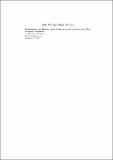| dc.contributor.advisor | Hutt, Peter Barton | en_US |
| dc.contributor.author | Torpoco, Edward A. | en_US |
| dc.date.accessioned | 2012-06-07T03:11:29Z | |
| dc.date.issued | 1997 | en_US |
| dc.identifier.citation | Why We Eat What We Eat: Explanations for Human Food Preferences and Implications for Government Regulation (1997 Third Year Paper) | en |
| dc.identifier.uri | http://nrs.harvard.edu/urn-3:HUL.InstRepos:8846767 | |
| dc.description.abstract | As this paper will demonstrate, however, understanding the reasons behind human food preferences can make a tremendous difference in the well-being of the world's people. To this end, Part II examines two competing theories for the origins of human food preferences: cultural idealism and cultural materialism. The first approach starts from the premise that human food preferences are fundamentally arbitrary--i.e., that food preferences are the results of irrational cultural prejudices--whereas the second theory posits that human food habits are rational adaptations to material conditions. Part III illustrates these two theory's explanations for two well-known food taboos: the American taboo on dog meat and the Indian taboo on cow slaughter. | en |
| dc.language.iso | en_US | en |
| dash.license | LAA | en_US |
| dc.subject | Food and Drug Law | en |
| dc.subject | cultural idealism | en |
| dc.subject | cultural materialism | en |
| dc.subject | taboo | en |
| dc.title | Why We Eat What We Eat: Explanations for Human Food Preferences and Implications for Government Regulation | en |
| dc.type | Paper (for course/seminar/workshop) | en_US |
| dc.date.available | 2012-06-07T03:11:29Z | |
| dash.authorsordered | false | |


